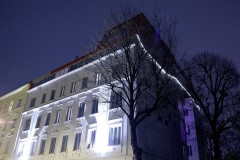In Austria a substantial portion of the building stock dates from the “Gründerzeit” period between 1848 and 1918; typical features are elaborate stucco façades, high ceilings and solid brick outside walls. In Austria buildings of this period house 600,000 flats – close to a fifth of the total number. Up to now little use has been made of these buildings‘ energy-saving potential. This is where the “Building of Tomorrow” flagship project comes to bear, to tackle integrated system approaches to modernizing “Gründerzeit” buildings. The aim here is to develop scalable renovation strategies with which to raise these buildings‘ thermal efficiency to an up-to-date standard; annual energy demand for space heating ought to be cut from around 120-160 kWh/m2 to less than 30 kWh/m2.
In collaboration with an interdisciplinary project team (Havel & Havel /social science, Manschein Managing Energy / monitoring, Österreichischer Verband der Immobilienwirtschaft / legal aspects, pos architekten / architecture, Schöberl & Pöll / structural engineering, Gemeinschaft Dämmstoff Industrie / dissemination) e7 Energie Markt Analyse GmbH are managing the project; it covers research into technical, economic and legal issues, developing new components and implementing pilot projects. In addition, cost-effectiveness is being analysed, sociological investigations carried out and the buildings monitored for energy consumption and comfort once they have been renovated.
Making the building envelope thermally efficient
The critical aspects here are how to insulate the segmented façades and the firewalls, and how the joints between structural elements are implemented. Structured façades that are worth conserving can be thermally insulated only on the inside; here either conventional insulants such as mineral fibre, or alternatively insulation panels, e. g. based on calcium silicate, can be employed. The latters‘ surface-active properties enable them to adsorb moisture, store it and release it into the air. For the key elements thermal-bridge simulations have been carried out and the impact on element reliability (water vapour condensing out, mould developing) has been investigated.
Employing efficient heating, ventilation etc.
Ventilation systems with heat recovery to replace used air with fresh air under full control have already proved their worth in renovated buildings. Modern ventilation strategies achieve excellent energy efficiency and ensure air exchange at controlled rates, resulting in an agreeable indoor climate. With their high ceilings, buildings from the period between 1848 and 1918 are ideal for installing ventilation systems. Apart from technical issues, a comprehensive strategy must also take economic, social and legal aspects into account. Experience gathered and tentative solutions have been documented in the course of the project. A guide to implementing the renovation of a “Gründerzeit” building in practice covers all relevant facets for interested parties, such as owners, property managers and planners.
Share

